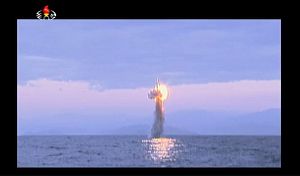On August 24, North Korea once again conducted a test of a submarine-launched ballistic missile (SLBM). Since Pyongyang carried out its third nuclear test in 2013, it has demonstrated strong commitment to the development of SLBMs. Indeed, the reclusive regime has continuously conducted SLBM ejection tests, starting with a ground test in October 2014; the most recent one was the eighth SLBM-related test. This time, the Bukkeukseong-1, also known as KN-11, was launched from a submarine at a steep angle, flew 500 kilometers, and fell into the water inside Japan’s air defense identification zone (ADIZ). Afterward, Pyongyag boasted of its capability to conduct both cold and hot launches within a relatively short period of test firing. The ROK-U.S. military has closely tracked the development of KN-11. The success of the latest test shows that the program may have been progressing faster than originally expected.
There are good reasons the North has been obsessed with SLBM development. First of all, in the domestic context, Pyongyang aims to use its SLBM capability in propaganda to convince the populace that the leadership is still strong and legitimate, while enhancing the high ranking officials’ loyalty at a time when an increasing number of the country’s elites continue to defect. Second, SLBM development is also aimed toward the South. Pyongyang has pressured Seoul through increasingly formidable nuclear might, and now it is attempting to further scare and ratchet up its pressure on South Korea by unveiling nuclear delivery vehicles like SLBMs, which can incapacitate Seoul’s anti-missile defense system.
Third, Pyongyang clearly intends to use its SLBM capability as leverage against Washington. The communist regime is eager to gain a seat at the negotiating table on an equal footing by flexing its offensive and retaliatory capability toward the United States. North Korea also hopes to generate a decoupling effect, cutting off reinforcement from U.S. forces in case of South Korean contingencies. Nuclear-armed submarines, due to their low detectability and lethality, are regarded as an effective offensive tool to launch covert attacks. Simultaneously, they constitute a resilient second strike force against preemptive strikes, thereby suppressing such attacks. The North’s SLBM is capable of hitting U.S. military bases in Guam and Okinawa, and, if done on a kamikaze-style one-way mission, the North can threaten the U.S. mainland with the current Sinpo-class submarines with a range of some 10,000 kilometers. To put it simply, Pyongyang is determined to show off its capability to take on Washington one on one through the deployment of SLBMs and legitimize its status as a nuclear weapons state.
It is important to note that what enables poverty-stricken North Korea, with the 174th largest GDP per capita in the world, to pursue the development of SLBM technology and play a nuclear blackmail game against the international community is China. Beijing, while joining the UN Security Council’s sanctions against Pyongyang, has issued a statement that “it opposes any measure which destabilizes North Korea’s regime and political system” and rejected any crippling sanctions against the North, thus flashing a green light for the regime’s nuclear development. Meanwhile, China, without any objective basis, has absurdly pressed against the South’s purely defensive actions. Although Seoul’s recent decision to deploy the Terminal High Altitude Area Defense (THAAD) system is focused squarely on defense against Pyongyang’s nuclear provocations, Beijing has staged all-out criticism on the global diplomatic stage.
China’s two-fold approach to North Korea shows its ulterior motive: using the nuclear North as a means to hold the China policy of the United States in check. As long as the new Cold War in East Asia keeps the two giants locked in a struggle, Beijing will continue to flip-flop on issues surrounding Pyongyang and pick on Seoul.
Against this backdrop, both the South and the international community as a whole now face a big dilemma. The international community is concerned over the possibility of the Nuclear Non-Proliferation Treaty (NPT) regime’s collapse over a nuclear domino effect in Asia. At the same time, Seoul’s dilemma is deepened as the North’s SLBMs further complicate the security landscape on the Korean peninsula. South Koreans, the most immediate would-be victim of Pyongyang’s nuclear attacks, know that Pyongyang’s SLBMs, if deployed sooner or later, can neutralize the South’s PAC-2 or soon-to-be-deployed THAAD system. Under the given circumstances, Seoul has no choice but to come up with new means of deterrence against the nuclear North.
On a positive note, however, the deceitful collaboration between China’s devious diplomatic play and the North’s nuclear weapon development will not continue to bear fruits. In fact, if South Korea takes the North’s development of SLBMs as an opportunity to pursue more aggressive measures to protect the country and the people, the North will have to engage in a fierce and toilsome arms race against a country with a GDP 45 times greater than its own.
In addition, China, in the mid- to long-term, will also face the consequences and may have to pay the price. China’s expansionary maritime strategies in East China Sea and South China Sea are already turning its neighbors into enemies. If China continues on its course to connive at the North’s wrongdoings, it will ultimately ruin ties with the South, which have continuously flourished since 1992, and fall onto a path of isolation. Certainly, this is not the path for China to grow as a responsible leader with the prestige congruous with its economic and military power.
Kim Tae-woo is Professor at Konyang University and Former President of the Korea Institute for National Unification (KINU).

































